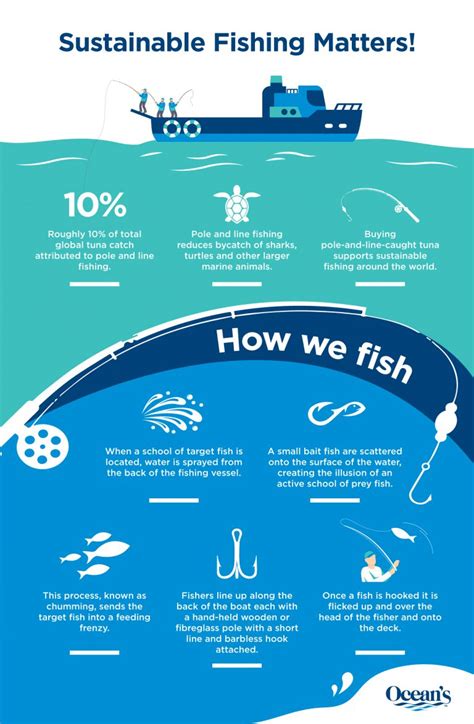Fishing is a significant industry globally, providing food, livelihoods, and economic benefits. However, fishing practices have come under scrutiny due to their potential to deplete fish populations, harm marine ecosystems, and impact biodiversity. Sustainable fishing practices have emerged as a critical approach to balancing the needs of fisheries with the long-term health of aquatic ecosystems.

Defining Sustainable Fishing Practices
Sustainable fishing practices prioritize the long-term viability of fish populations and ecosystems while minimizing negative environmental impacts. Key principles include:
- Maintaining Fish Stocks: Ensuring fish populations remain at healthy levels to support current and future fishing activities.
- Protecting Marine Ecosystems: Minimizing disturbance to marine habitats, preventing bycatch (unintended capture of non-target species), and mitigating pollution.
- Managing Fishery Resources: Establishing regulations, quotas, and monitoring systems to prevent overfishing and ensure sustainable harvests.
- Respecting Indigenous Rights: Acknowledging the rights, knowledge, and traditional practices of Indigenous communities in fisheries management.
Benefits of Sustainable Fishing Practices
Embracing sustainable fishing practices offers numerous benefits:
- Secure Food Sources: Maintaining healthy fish populations ensures a reliable supply of food for present and future generations.
- Protect Biodiversity: Limiting bycatch and habitat damage helps preserve marine biodiversity, which is essential for ecosystem health.
- Economic Stability: Sustainable practices ensure the long-term productivity of fisheries, supporting livelihoods and economic growth in coastal communities.
- Environmental Conservation: Protecting marine ecosystems benefits other species, including endangered and threatened species.
- Improved Public Health: Reducing pollution and minimizing the use of antibiotics in aquaculture helps protect consumer health.
Indicators of Sustainable Fishing Practices
Several indicators can help identify sustainable fishing practices:
- Independent Certifications: Reputable third-party organizations, such as the Marine Stewardship Council (MSC) and the Aquaculture Stewardship Council (ASC), provide certification programs verifying fisheries meet sustainability standards.
- Fishing Gear Selectivity: Using gear that targets specific fish species while minimizing bycatch reduces impacts on non-target populations.
- Habitat Protection and Restoration: Implementing measures to protect or restore marine habitats ensures the availability of fish breeding grounds and nursery areas.
- Reduced Pollution: Adopting practices that minimize pollution from fishing vessels, aquaculture facilities, and seafood processing plants helps maintain water quality.
- Respect for Indigenous Rights: Engaging with Indigenous communities to incorporate their knowledge and practices into fishery management enhances sustainability.
Challenges to Sustainable Fishing
Implementing sustainable fishing practices faces challenges:
- Illegal, Unreported, and Unregulated (IUU) Fishing: IUU fishing undermines sustainability efforts by operating outside regulations and depleting fish stocks.
- Overcapacity and Overfishing: Excessive fishing effort can lead to overfishing, depleting populations below sustainable levels.
- Climate Change: Rising sea temperatures, ocean acidification, and extreme weather events pose challenges to fish populations and marine ecosystems.
- Market Demand: Consumer demand for seafood can drive unsustainable fishing practices if not met with sustainable supply chains.
- Lack of Enforcement and Monitoring: Ensuring compliance with fishing regulations requires effective enforcement and monitoring mechanisms.
Overcoming Challenges and Promoting Sustainable Fishing
Overcoming these challenges requires collaboration among stakeholders:
- Policy Improvements: Governments and international organizations should strengthen fishing regulations, promote sustainable practices, and combat IUU fishing.
- Consumer Awareness and Education: Raising consumer awareness about sustainable seafood choices drives demand for products from sustainable fisheries.
- Technological Advancements: Developing new fishing technologies and gear that minimize bycatch and habitat damage can enhance sustainability.
- Industry Best Practices: Fishing companies and seafood processors should adopt and promote sustainable practices throughout their supply chains.
- International Cooperation: Collaboration between countries is crucial to address transboundary fishing issues and promote sustainability on a global scale.
Conclusion
Sustainable fishing practices are essential for the long-term health of fish populations, marine ecosystems, and the livelihoods of those who rely on fisheries. By embracing sustainability principles, implementing effective management measures, and overcoming challenges, we can ensure the viability of fisheries for generations to come.
